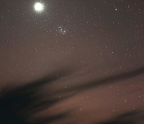Looking for Ice in the dark

TORCHES (OR FLASHLIGHTS AS THEY SAY IN THE U.S.) help us find our way through pitch-black bushland or a house that’s just lost power. But researchers want to use a torch in another way: to find and characterise water ice in one of the darkest, coldest places in the solar system — the Moon.
Astronomers already know that patches of ice exist on the lunar surface at both the north and south poles. Hidden from direct sunlight and thus extremely cold, these regions are where ice delivered by comet impacts and other processes can gradually accumulate and survive on geologic time scales. The distribution of water ice in these cold traps varies between the poles, from place to place, and even within a single deposit.
But scientists know little about this ice. To explore these frozen regions, Barbara Cohen (NASA Goddard) leads the Lunar Flashlight mission, a CubeSat about the size of a box of detergent that will fly to the Moon in late 2021. The probe will scan dark craters near the lunar south pole to better understand deposits of water ice there. It’s one of several to be carried aboard Artemis 1, the first (and uncrewed) trip of NASA’s new astronauts-to-the-Moon program. Other upcoming probes will also investigate lunar ice, helping to pave the way for the first NASA-built Moon rover and, perhaps, the eventual development of a cislunar economy.
Ground truth
Water on the Moon is not a new idea. In pretelescopic times, people speculated that the lava plains called (Latin for seas) actually were seas. In the early
You’re reading a preview, subscribe to read more.
Start your free 30 days





